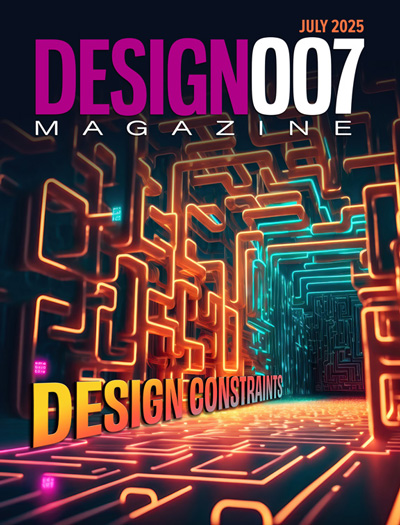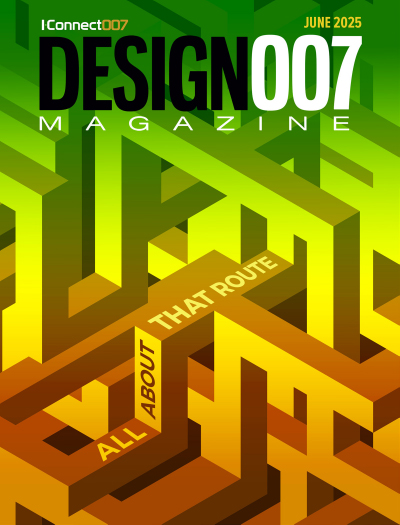-

- News
- Books
Featured Books
- design007 Magazine
Latest Issues
Current Issue
Showing Some Constraint
A strong design constraint strategy carefully balances a wide range of electrical and manufacturing trade-offs. This month, we explore the key requirements, common challenges, and best practices behind building an effective constraint strategy.

All About That Route
Most designers favor manual routing, but today's interactive autorouters may be changing designers' minds by allowing users more direct control. In this issue, our expert contributors discuss a variety of manual and autorouting strategies.

Creating the Ideal Data Package
Why is it so difficult to create the ideal data package? Many of these simple errors can be alleviated by paying attention to detail—and knowing what issues to look out for. So, this month, our experts weigh in on the best practices for creating the ideal design data package for your design.
- Articles
- Columns
- Links
- Media kit
||| MENU - design007 Magazine
IPC, FED Partner for New Design Conference in Vienna
December 12, 2024 | Andy Shaughnessy, Design007 MagazineEstimated reading time: 2 minutes
IPC and its German partner FED have teamed up to create a new PCB design conference in Vienna, Austria. The Pan-European Electronics Design Conference (PEDC) is scheduled for Jan. 29-30 at the NH Danube City hotel in Vienna.
IPC’s Peter Tranitz, one of the show organizers, discussed how this new show came about, pointing out that, unlike many of the regional conferences in Europe, PEDC will host curated, peer-reviewed presentations, not promotional content or product pitches. Will PEDC become an annual event?
Andy Shaughnessy: Peter, tell us about the new design conference in Vienna, Austria.
Peter Tranitz: The idea for the Pan-European Electronics Design Conference came out of discussions that IPC and FED (Germany-based electronics design and manufacturing association) had with the PCB and EMS communities around our activities in Brussels. During those discussions, we learned that high-level scientific conferences are missing within the European landscape. In Europe, we have regional language conferences on electronic design organized by national associations. Often, little care is taken to avoid promotional and product pitches.
The PEDC is targeting the pan-European community for electronics design. We are transporting the model of the IPC APEX EXPO conference, which excludes commercialism and ensures a high level of technical content for the presentations. Our technical program committee is targeting content with a high technical and scientific level. This pure, technically scientific approach is the differentiator from other events happening in Europe. We prefer presentations that haven't been published before, so that attendees see the content for the first time.
Shaughnessy: Are the presentations in English? What does the program consist of?
Tranitz: Yes, it’s all English. We are open to engineers of all levels to academia and students, and we embrace diversity. We are seeking European participants as well as interested people from around the globe. Our Day 1 program consists of two keynotes. One is focused on electronic design and AI utilization, and the other keynote is around silicon-to-systems development. We have two panels: One tackles AI in electronics, and the other focuses on regulations and sustainability. These are big topics, especially in Europe.
On Day 2, we have two tracks with 12 presentations, each in parallel. One track focuses on silicon-to-systems and design techniques, and the other is around design for excellence, software, and tools. We’ve managed to engage professors from academia, top experts from research institutes, and companies that do a lot of research and development to help us set up a very attractive program. It is also worth mentioning that we have received far more presentation abstracts than we can cover at the conference.
To read this entire conversation, which appeared in the December 2024 issue of Design007 Magazine, click here.
Testimonial
"Our marketing partnership with I-Connect007 is already delivering. Just a day after our press release went live, we received a direct inquiry about our updated products!"
Rachael Temple - AlltematedSuggested Items
Ansys 2025 R2 Enables Next-Level Productivity by Leveraging AI, Smart Automation, and Broader On-Demand Capabilities
07/30/2025 | PRNewswireAnsys, now part of Synopsys, announced 2025 R2, featuring new AI-powered capabilities across the portfolio that accelerate simulation and expand accessibility.
Target Condition: The 5 Ws of PCB Design Constraints
07/29/2025 | Kelly Dack -- Column: Target ConditionHave you ever sat down to define PCB design constraints and found yourself staring at a settings window with more checkboxes than a tax form? You’re not alone. For many designers—especially those newer to the layout world—the task of setting up design constraints can feel like trying to write a novel in a language you just started learning.
Zuken to Showcase Defence & Security-Focused Electronic Systems Design Solutions at DSEI 2025
07/24/2025 | ZukenZuken, a global leader in electronic and electrical design automation, will showcase its latest innovations for defence and security systems at DSEI 2025, taking place at ExCeL London from 9–12 September 2025.
Creating a Design Constraint Strategy
07/24/2025 | I-Connect007 Editorial TeamMost designers learn how to set their design constraints through trial and error. EDA vendors’ guidelines explain how to use their particular tools’ constraints, and IPC standards offer a roadmap, but PCB designers usually develop their own unique styles for setting constraints. Is there a set of best practices for setting constraints? That’s what I asked Global Electronics Association design instructor Kris Moyer, who covers design constraints in his classes.
Elementary Mr. Watson: Closing the Gap Between Design and Manufacturing
07/23/2025 | John Watson -- Column: Elementary, Mr. WatsonModern PCB designers are not merely engineers or technicians. I believe that PCB design, at its core, is an art form, and modern PCB designers should be considered artists. Beyond the technical calculations and engineering rules lies a creative process that involves vision, balance, and a passion for what we do. Like any artist who works with brush and canvas or chisel and stone, a PCB designer shapes invisible pathways that bring ideas to life. Each trace, layer, and component placement reflects thoughtful decisions that blend form, fit, and function.


